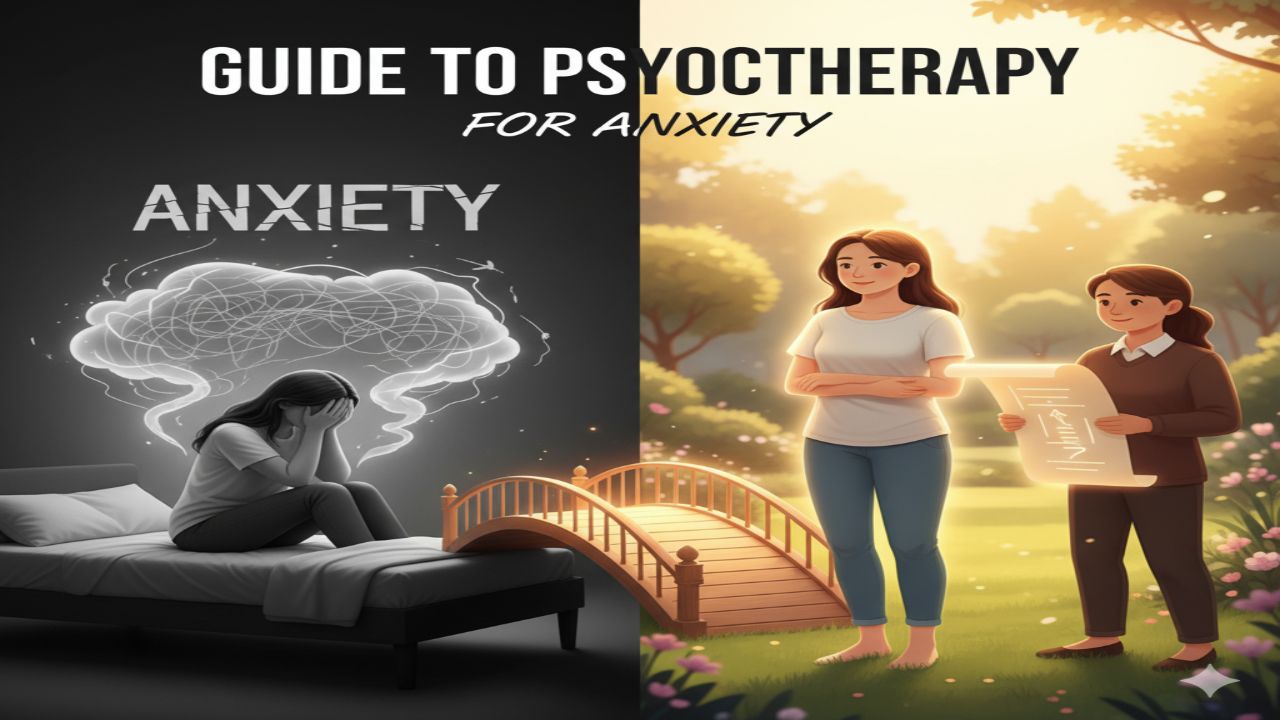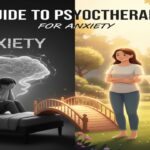Anxiety is one of the most common mental health challenges of our time. Whether it manifests as generalized worry, panic attacks, social fears, or specific phobias, anxiety can significantly impact your quality of life. The good news? Psychotherapy offers powerful, evidence-based treatments that can help you reclaim your peace of mind.
But with so many therapy approaches available, how do you know which one is right for you? This comprehensive guide explores the most effective psychotherapy options for anxiety, helping you make an informed decision about your mental health care.
Understanding Anxiety: More Than Just Worry
Before exploring treatment options, it’s important to understand what you’re treating. Anxiety isn’t simply feeling nervous before a presentation or worried about an upcoming event. Clinical anxiety involves persistent, excessive worry that interferes with daily functioning.
Anxiety disorders include generalized anxiety disorder (GAD), panic disorder, social anxiety disorder, specific phobias, and others. While each has unique features, they share common elements: intrusive thoughts, physical symptoms like rapid heartbeat or sweating, and avoidance behaviors that limit your life.
The physical symptoms of anxiety—racing heart, shortness of breath, muscle tension, digestive issues—aren’t “just in your head.” Your brain’s threat-detection system has become overactive, triggering real physiological responses to perceived dangers that may not actually threaten you.
Why Psychotherapy Works for Anxiety
Unlike medication, which manages symptoms while you’re taking it, psychotherapy addresses the underlying patterns of thinking and behavior that maintain anxiety. Research consistently shows that psychotherapy produces lasting changes that continue even after treatment ends.
Therapy helps you understand the roots of your anxiety, develop coping skills, change unhelpful thought patterns, and gradually face feared situations. It provides a safe space to process emotions and practice new responses to anxiety-provoking situations.
Cognitive Behavioral Therapy (CBT): The Gold Standard
Cognitive Behavioral Therapy is the most extensively researched and widely used treatment for anxiety disorders. Decades of studies confirm its effectiveness across all types of anxiety.
How CBT Works
CBT is based on the premise that our thoughts, feelings, and behaviors are interconnected. Anxiety often stems from distorted thinking patterns—catastrophizing, overgeneralizing, or assuming the worst. These thoughts trigger anxious feelings, which lead to avoidance behaviors that reinforce the anxiety cycle.
CBT helps you identify these patterns and replace them with more balanced, realistic thinking. A CBT therapist acts as a coach, teaching you skills you can apply independently.
The CBT Process
Psychoeducation: You’ll learn how anxiety works in the brain and body, why it persists, and how treatment addresses it. Understanding your anxiety reduces its power.
Cognitive Restructuring: You’ll identify automatic negative thoughts and examine evidence for and against them. Is the worst-case scenario you imagine truly likely? Are there alternative explanations?
Behavioral Experiments: You’ll test your anxious predictions in real life to see if they come true. Usually, feared outcomes don’t materialize, which gradually reduces anxiety.
Exposure: This crucial component involves gradually facing feared situations rather than avoiding them. Exposure breaks the avoidance cycle that maintains anxiety.
Skill Building: You’ll learn practical techniques like relaxation exercises, problem-solving strategies, and assertiveness skills.
What Makes CBT Effective
CBT is typically short-term (12-20 sessions), structured, and goal-oriented. You’ll receive homework assignments to practice skills between sessions, accelerating progress.
Research shows that 60-80% of people with anxiety disorders experience significant improvement with CBT. The skills learned become lifelong tools for managing anxiety.
Best For
CBT excels at treating generalized anxiety disorder, panic disorder, social anxiety, and specific phobias. It’s ideal if you want a structured, skills-based approach with measurable progress.
Exposure Therapy: Facing Your Fears
While exposure is a component of CBT, some therapists specialize in exposure-based treatments that make confronting fears the central focus.
How Exposure Therapy Works
Anxiety thrives on avoidance. When you avoid something you fear, you get temporary relief, but this reinforces the belief that the situation is dangerous. Exposure therapy systematically helps you face feared situations in a controlled, gradual way.
Through repeated exposure, your nervous system learns that the feared outcome either doesn’t occur or is manageable. This process, called habituation, reduces anxiety over time.
Types of Exposure
Imaginal Exposure: You vividly imagine feared scenarios while learning to tolerate the anxiety they provoke.
In Vivo Exposure: You directly confront real-life situations you’ve been avoiding, starting with less anxiety-provoking situations and progressing to more challenging ones.
Interoceptive Exposure: For panic disorder, you deliberately induce physical sensations associated with panic (like rapid breathing or increased heart rate) to learn these sensations aren’t dangerous.
Virtual Reality Exposure: Using VR technology, you can safely experience feared situations like flying or heights in a controlled therapeutic setting.
What Makes Exposure Effective
Exposure must be prolonged enough for anxiety to decrease naturally. Brief exposure that ends while anxiety is high can actually worsen fears. A skilled therapist ensures exposures are appropriately paced and long enough to produce learning.
Best For
Exposure therapy is particularly effective for specific phobias, social anxiety disorder, panic disorder, and PTSD. It’s ideal if avoidance has significantly limited your life and you’re ready to actively confront your fears.
Acceptance and Commitment Therapy (ACT): A Mindfulness-Based Approach
ACT (pronounced as the word “act”) represents a newer wave of behavioral therapy that takes a different approach to anxiety.
How ACT Works
Rather than trying to eliminate anxious thoughts and feelings, ACT teaches you to change your relationship with them. The goal isn’t to stop feeling anxious but to live a meaningful life even when anxiety is present.
ACT emphasizes six core processes:
Acceptance: Instead of struggling against uncomfortable feelings, you learn to make room for them without judgment.
Cognitive Defusion: You learn to observe thoughts as mental events rather than absolute truths. A thought like “I’m going to fail” becomes “I’m having the thought that I might fail.”
Being Present: Mindfulness practices help you stay grounded in the current moment rather than ruminating about the past or worrying about the future.
Self-as-Context: You develop perspective on your experiences, recognizing that you’re more than your anxious thoughts and feelings.
Values: You clarify what truly matters to you—relationships, creativity, service, growth—and use these values as a compass.
Committed Action: You take action aligned with your values, even when anxiety is present.
What Makes ACT Effective
ACT recognizes that trying to control or eliminate anxiety often backfires, creating more struggle. By learning to coexist with anxiety while pursuing meaningful goals, you reduce its impact on your life.
Research shows ACT is effective for various anxiety disorders, particularly when anxiety is accompanied by experiential avoidance—avoiding thoughts, feelings, and situations to prevent discomfort.
Best For
ACT works well for people who’ve tried other therapies without lasting success, those dealing with chronic worry, and individuals who resonate with mindfulness-based approaches. It’s especially helpful when anxiety is entangled with other concerns like chronic pain or depression.
Dialectical Behavior Therapy (DBT): Skills for Emotional Regulation
Originally developed for borderline personality disorder, DBT has proven effective for anxiety, particularly when intense emotions feel overwhelming.
How DBT Works
DBT teaches four categories of skills:
Mindfulness: Present-moment awareness helps you observe anxiety without being consumed by it.
Distress Tolerance: You learn crisis survival skills for managing intense anxiety in the moment without making things worse.
Emotion Regulation: Skills for identifying, understanding, and modifying emotional responses reduce the intensity and frequency of anxious episodes.
Interpersonal Effectiveness: Communication and relationship skills address social anxiety and relationship-related worries.
What Makes DBT Effective
DBT provides concrete, practical skills you can use immediately. The emphasis on validation—accepting yourself and your struggles while working toward change—creates a supportive framework for growth.
Best For
DBT is particularly helpful for anxiety accompanied by emotional intensity, self-destructive behaviors, or difficulty regulating emotions. It’s excellent for people who need concrete skills for managing overwhelming feelings.
Psychodynamic Therapy: Understanding the Roots
Psychodynamic therapy explores how past experiences, unconscious patterns, and unresolved conflicts contribute to current anxiety.
How Psychodynamic Therapy Works
A psychodynamic therapist helps you explore childhood experiences, relationships, and unconscious patterns that may underlie anxiety. By bringing these patterns to awareness, you can understand and change them.
This approach examines defense mechanisms—unconscious strategies for managing anxiety—and helps you develop healthier coping methods. The therapeutic relationship itself becomes a tool for understanding relationship patterns that may contribute to anxiety.
What Makes Psychodynamic Therapy Effective
For some people, anxiety reflects deeper emotional conflicts that require understanding, not just symptom management. Psychodynamic therapy addresses these root causes, potentially leading to profound, lasting change.
Best For
Psychodynamic therapy suits those interested in self-exploration and insight, particularly when anxiety relates to relationship patterns, early experiences, or persistent feelings that other treatments haven’t fully addressed. It typically requires longer-term commitment than CBT.
Interpersonal Therapy (IPT): Addressing Relationship Issues
IPT focuses on how interpersonal relationships and life transitions contribute to anxiety.
How IPT Works
IPT examines four problem areas: unresolved grief, role disputes, role transitions, and interpersonal deficits. If your anxiety relates to relationship conflicts, life changes, or social isolation, IPT addresses these connections directly.
The therapy helps you improve communication skills, resolve conflicts, and adapt to life changes that trigger anxiety.
Best For
IPT is ideal when anxiety stems from or is exacerbated by relationship problems, major life transitions, or social difficulties. It’s particularly effective for social anxiety disorder.
Mindfulness-Based Stress Reduction (MBSR): The Power of Present-Moment Awareness
MBSR, developed by Jon Kabat-Zinn, uses mindfulness meditation to reduce anxiety and stress.
How MBSR Works
Through guided meditation practices, body scans, and gentle yoga, you learn to observe thoughts and sensations without judgment. This practice interrupts anxious rumination and helps you respond to stress more skillfully.
MBSR typically involves an 8-week group program with daily home practice. The structured format and group support enhance learning.
What Makes MBSR Effective
Regular mindfulness practice creates structural changes in the brain, particularly in areas involved in emotional regulation and stress response. These changes support long-term anxiety reduction.
Best For
MBSR works well for generalized anxiety, stress-related anxiety, and people who prefer a holistic, non-pathologizing approach. It requires commitment to daily practice.
Group Therapy: The Power of Shared Experience
Many effective anxiety treatments can be delivered in group formats, offering unique benefits.
Advantages of Group Therapy
Reduced Isolation: Discovering others share similar struggles reduces shame and loneliness.
Vicarious Learning: Observing others’ progress and strategies provides additional learning opportunities.
Social Support: Group members encourage and support each other’s growth.
Reality Testing: The group provides feedback that challenges anxious thoughts and assumptions.
Cost-Effective: Group therapy typically costs less than individual therapy while maintaining effectiveness.
Best For
Group therapy works well for social anxiety (providing built-in exposure), generalized anxiety, and panic disorder. It’s ideal if you want peer support and don’t require intensive individual attention.
How to Choose the Right Therapy for You
With so many effective options, how do you decide?
Consider Your Preferences
Time Frame: CBT and exposure therapy tend to be shorter-term (12-20 sessions). Psychodynamic therapy often continues longer.
Structure: Some people prefer the structured, homework-based approach of CBT. Others want more open-ended exploration.
Focus: Do you want to understand the roots of your anxiety, or learn skills to manage it? Both approaches work.
Match Therapy to Your Specific Anxiety
Panic Disorder: CBT with interoceptive exposure or ACT
Social Anxiety: CBT with exposure, group CBT, or IPT
Generalized Anxiety Disorder: CBT, ACT, or MBSR
Specific Phobias: Exposure therapy
Complex Anxiety with Multiple Issues: DBT or psychodynamic therapy
The Therapist Matters More Than the Method
Research consistently shows that the therapeutic relationship predicts outcomes as strongly as the specific approach. A skilled, compassionate therapist using a method that’s a good fit for them can achieve excellent results.
Look for a therapist who:
- Has specialized training in treating anxiety
- Uses evidence-based approaches
- Creates a safe, non-judgmental space
- Collaborates with you on treatment goals
- You feel comfortable with and trust
Combining Approaches
Many therapists integrate elements from multiple approaches. Your therapist might use CBT techniques while incorporating mindfulness practices and exploring how past experiences influence current patterns.
This flexibility allows treatment to be tailored to your unique needs and preferences.
What About Medication?
While this article focuses on psychotherapy, medication can be an important part of anxiety treatment. The most effective approach for many people combines therapy with medication, particularly for severe anxiety.
Therapy provides skills and insights that continue working after treatment ends, while medication can provide relief that makes engaging in therapy easier. Discuss all treatment options with your healthcare provider.
How Long Does Therapy Take?
The timeline varies based on the approach, severity of anxiety, and individual factors.
CBT and Exposure Therapy: Often show significant improvement in 12-20 sessions, though some people benefit from longer treatment.
ACT and DBT: Typically 16-24 sessions, with ongoing practice of learned skills.
Psychodynamic Therapy: Often continues for months to years, depending on goals.
MBSR: 8-week structured program with ongoing personal practice.
Remember that improvement isn’t always linear. You might experience setbacks, which are normal parts of the recovery process.
Getting Started
Taking the first step toward treatment can feel daunting, especially when you’re anxious. Here’s how to begin:
Find a Qualified Therapist
- Ask your doctor for referrals
- Check with your insurance company for in-network providers
- Search professional directories (Psychology Today, ADAA)
- Ask for recommendations from trusted friends or family
- Contact local mental health clinics or universities with training programs
Prepare for Your First Session
- Write down your symptoms, what triggers anxiety, and how it affects your life
- List previous treatments you’ve tried
- Bring questions about the therapist’s approach and experience
- Be honest about your concerns and preferences
Give It Time
It typically takes a few sessions to build rapport and determine if a therapist is a good fit. If you don’t feel comfortable after several sessions, it’s okay to try someone else.
The Bottom Line
No single psychotherapy approach is universally “best” for anxiety. The most effective treatment is one that’s evidence-based, delivered by a skilled therapist, and aligned with your preferences and needs.
CBT and exposure therapy have the strongest research support, particularly for specific anxiety disorders. However, ACT, DBT, psychodynamic therapy, IPT, and MBSR all offer valuable pathways to healing.
The courage to seek help is itself a powerful step toward recovery. With the right support and commitment to the process, you can develop the skills and insights to manage anxiety effectively and reclaim your life.
You don’t have to live with overwhelming anxiety. Effective help is available, and lasting relief is possible.
Important Note: This article provides general information about psychotherapy for anxiety and should not replace professional mental health care. If you’re experiencing severe anxiety, panic attacks, thoughts of self-harm, or symptoms that significantly impair your functioning, please seek professional help immediately. Contact a mental health professional, your doctor, or a crisis hotline for support.








